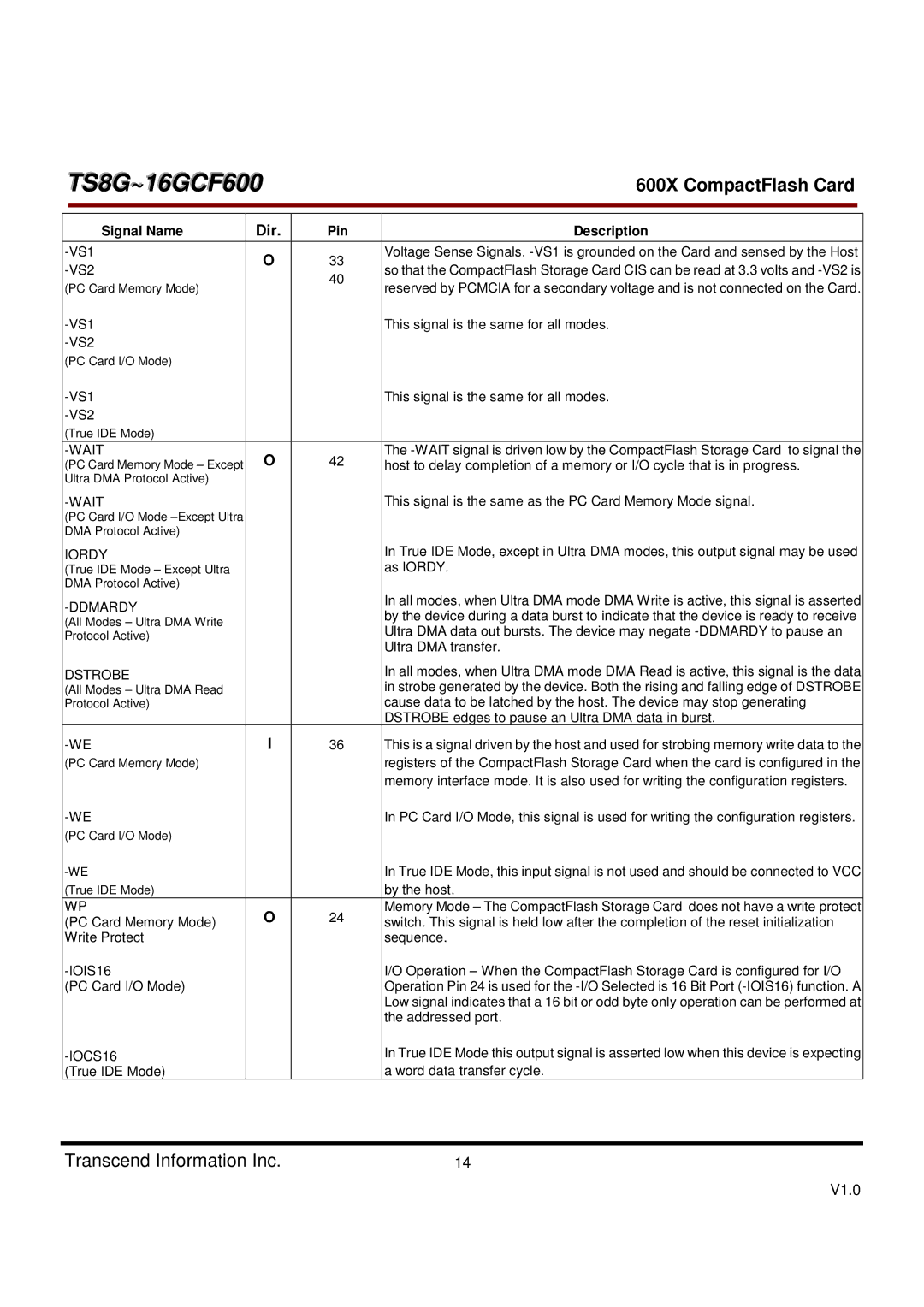
TS8G~16GCF600 |
| 600X CompactFlash Card | ||||
|
|
|
|
|
| |
|
|
|
|
| ||
| Signal Name | Dir. | Pin | Description | ||
O | 33 | Voltage Sense Signals. | ||||
so that the CompactFlash Storage Card CIS can be read at 3.3 volts and | ||||||
| 40 | |||||
(PC Card Memory Mode) |
| reserved by PCMCIA for a secondary voltage and is not connected on the Card. | ||||
|
| |||||
|
| This signal is the same for all modes. | ||||
|
|
|
| |||
(PC Card I/O Mode) |
|
|
|
| ||
|
| This signal is the same for all modes. | ||||
|
|
|
| |||
(True IDE Mode) |
|
|
|
| ||
O | 42 | The | ||||
(PC Card Memory Mode – Except | host to delay completion of a memory or I/O cycle that is in progress. | |||||
|
| |||||
Ultra DMA Protocol Active) |
|
|
|
| ||
|
| This signal is the same as the PC Card Memory Mode signal. | ||||
(PC Card I/O Mode |
|
|
|
| ||
DMA Protocol Active) |
|
|
|
| ||
IORDY |
|
| In True IDE Mode, except in Ultra DMA modes, this output signal may be used | |||
|
| as IORDY. | ||||
(True IDE Mode – Except Ultra |
|
| ||||
DMA Protocol Active) |
|
|
|
| ||
|
|
| In all modes, when Ultra DMA mode DMA Write is active, this signal is asserted | |||
|
| by the device during a data burst to indicate that the device is ready to receive | ||||
(All Modes – Ultra DMA Write |
|
| ||||
|
| Ultra DMA data out bursts. The device may negate | ||||
Protocol Active) |
|
| ||||
|
| Ultra DMA transfer. | ||||
|
|
|
| |||
DSTROBE |
|
| In all modes, when Ultra DMA mode DMA Read is active, this signal is the data | |||
|
| in strobe generated by the device. Both the rising and falling edge of DSTROBE | ||||
(All Modes – Ultra DMA Read |
|
| ||||
Protocol Active) |
|
| cause data to be latched by the host. The device may stop generating | |||
|
|
|
| DSTROBE edges to pause an Ultra DMA data in burst. | ||
I | 36 | This is a signal driven by the host and used for strobing memory write data to the | ||||
(PC Card Memory Mode) |
|
| registers of the CompactFlash Storage Card when the card is configured in the | |||
|
|
|
| memory interface mode. It is also used for writing the configuration registers. | ||
|
| In PC Card I/O Mode, this signal is used for writing the configuration registers. | ||||
(PC Card I/O Mode) |
|
|
|
| ||
|
| In True IDE Mode, this input signal is not used and should be connected to VCC | ||||
(True IDE Mode) |
|
| by the host. | |||
WP | O | 24 | Memory Mode – The CompactFlash Storage Card does not have a write protect | |||
(PC Card Memory Mode) | switch. This signal is held low after the completion of the reset initialization | |||||
|
| |||||
Write Protect |
|
| sequence. | |||
|
| I/O Operation – When the CompactFlash Storage Card is configured for I/O | ||||
(PC Card I/O Mode) |
|
| Operation Pin 24 is used for the | |||
|
|
|
| Low signal indicates that a 16 bit or odd byte only operation can be performed at | ||
|
|
|
| the addressed port. | ||
|
| In True IDE Mode this output signal is asserted low when this device is expecting | ||||
|
|
|
| |||
(True IDE Mode) |
|
| a word data transfer cycle. | |||
Transcend Information Inc. | 14 |
V1.0
